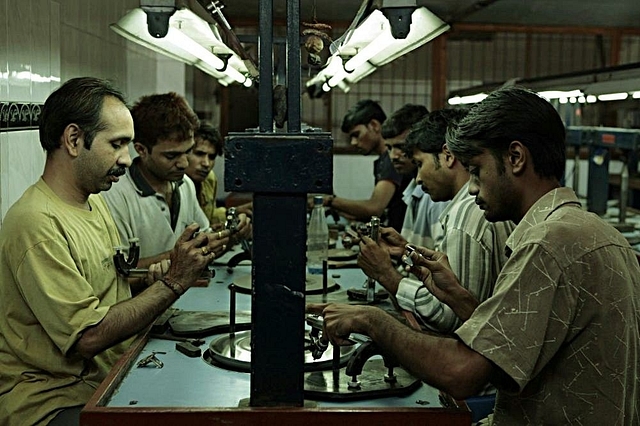
Swadeshi Circle: How Bharat Can Be Helped To Its Feet Before India is Set Free To Run The Economic Race
Building swadeshi circles would go a long way in managing the dichotomy between India and Bharat — that is balancing the need for protectionism and addressing global competitiveness.
India is going through a growth and employment slowdown. Many explanations are being forwarded, from demonetisation and flawed goods and services tax (GST) implementation to mounting non-performing assets (NPAs) accumulated over the years.
Forgotten in the blame game is the fact that all these are merely surface triggers of the main problem — a skewed multiplier effect due to the following demand-supply-employment discrepancies:
- Increasing displacement of unskilled labour due to changing technology. This siphons off multiplier effect to the rich and highly-skilled who have a lower propensity to consume.
- Rising imports from countries such as China drains demand and multiplier benefit out of the country.
- These two, coupled with short-term problem of cash crunch and demand postponement has further dampened the multiplier effect.
The fallout of this discrepancy is disproportionately felt by the most vulnerable sections of the economy — Bharat rather than India.
Unfortunately, corrective measures such as bank rate reductions, income tax reductions, GST tinkering etc, continue to address ‘India’, rather than ‘Bharat’.
They reflect the larger bias in our economic policy. We tend to protect vocal India (think corporate bailouts), rendering it globally uncompetitive, while tongue-tied Bharat is ignored to the point of making it feel suicidal.
We need to do exactly the opposite. We need to set India free and nurse back to good health the weak, unfed, poor Bharat instead.
A direct affirmative action would be a spending boost targeted to consume swadeshi output by Bharat, with care taken to localise the multiplier effect.
Swadeshi output could be defined as goods and services produced,
- Using largely indigenous resources and/or
- With a high rate of indigenous employment to output ratio even if resources are largely imported.
Direct government spending and release of pending bills on such swadeshi output can create initial demand.
However, it cannot prevent leaking out of ensuing multiplier effect in the form of say purchase of mobile phones from China or gold from Dubai. Nor can it direct private demand to this output.
A more assured way would be for the government to issue digital swadeshi coupons, which can only be used for purchasing swadeshi output, creating a reciprocal swadeshi trade circle of sorts.
The GEM e-marketplace or equivalent could be repurposed to register swadeshi output online. Swadeshi coupons would only be valid for purchasing this registered output, through online transfers linked to Aadhaar numbers.
The coupons would be non-convertible, a form of online gift vouchers/limited purpose Central Bank Digital Currency (CBDC). They would carry a fixed expiry date such as one financial year, to encourage spend within a stipulated period.
There are multiple ways in which the government could inject swadeshi coupons into the economy:
- As a percentage of minimum price of farm goods or wages for employment guarantee schemes.
- In lieu of tax rebates or even tax hikes — pay higher tax or buy swadeshi coupons of same amount.
- As percentage of interest rates from government bonds and so on.
The swadeshi circle could take many avatars depending upon registration criteria laid down by the government.
The circle could be based on the type of companies, narrowed down to include output from small farmers, rural artisans, micro industries and small and medium enterprises (SMEs) or broadened to include five-star hotels and large India corporates.
You could have a geographically-based swadeshi circle that operates strictly for rural/mofussil goods in our country, or a broader circle incorporating handicrafts from Africa.
Startups could get a boost with their inclusion in swadeshi circle. Another variation is only inclusion of output that is environment friendly.
Meanwhile, nothing will stop this output from being simultaneously traded in the open market. If a particular swadeshi output cross a certain level of trade in the open market it could be automatically exited from the swadeshi circle.
As income accruing from the sale of swadeshi output can only be spent within the swadeshi circle, the multiplier effect will be localised to the circle, creating reciprocal demand and employment. Plus, limited period validity will ensure immediate demand, whatever the market mood.
Other benefits include:
- Digitisation of the section that is most prone to cash transactions.
- No tax leakage within the swadeshi circle.
- Easy tracking of multiplier effect within the circle.
- Government can increase taxation rates in the whole economy without damaging the growth incentive, as increased taxes can be traded for swadeshi coupons.
Once you have created a safe haven for Bharat within the swadeshi circle, India can be set free to rage on in the international economy. No crippling labour policies, no curbs on imports of resources or technology, no investment constraints on foreign direct investment (FDI) and no unviable taxation rates.
On the other hand, no protectionism, no bad loans against non-performance, no entitlement economics and unfair bailouts (profits mine, losses yours) — none of that. Let the firms get globally competitive by going through the rough and tumble of fierce international competition.
Startup India does not share corporate India’s entitlement mindset. Unfortunately, it is being actively harassed in the name of tax collection and obsolete law compliance. Instead, government should let a million startups bloom through infra support, tax rebates and even cooption into the swadeshi circle.
Swadeshi circles and startup encouragement along with freedom for the corporates could be a good way to manage the dichotomy between India and Bharat, between the need for protectionism and global competitiveness, till Bharat stands up on its feet again and is ready to run the race along with India.